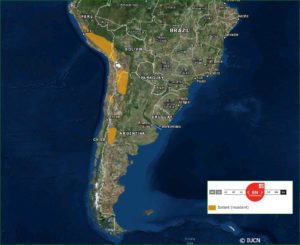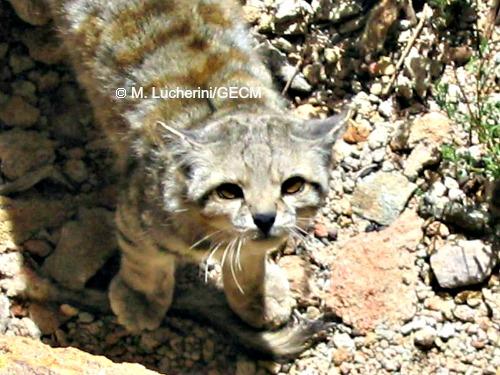- HB Length:57-64 cm (22-25″)
- Tail Length:41-48 cm (16-19″)
- Height: Appr 36 cm (14″)
- Weight: 4 – 6 kg (8 – 13 lbs)
- Pop. Trend: Decreasing
The Andean cat Leopardus jacobita is one of the most beautiful of all wild cats. The fur is mainly ash grey with brown-yellowish blotches that are distributed as vertical lines at both sides of the body, giving the appearance of continuous stripes. Extremely thick, plush fur is very fine and soft, up to 5 cm long on the back, and the underside is pale with dark spots. Prominent dark grey bars also run across the chest and forelegs. The backs of the large, rounded ears are dark grey, and the nose is black.
The legs also have dark and narrower blotches or stripes, but they don’t form complete rings. Large feet are marked with blackish bars and spots, and the soles are greyish-brown. Their magnificent tail is about 70% as long as the head body length. Because the tail’s underside has hair as long and as thick as the upper side, it appears perfectly round. It is ringed with six to nine dark bands, and has a black tip. This long tail is probably an aid to balance when hunting in rocky habitat. It is likely also used for warmth, wrapping it around the body when asleep, tucking the nose inside.
There is no variation between the fur colour of males or females, but differences between juvenile and adult specimens have been found. The juveniles have a lighter colouration and more and smaller blotches, which means the young can be confused much more easily with Pampas Cats Leopardus colocolo.
Distribution

The Andean cat occurs mainly in the high Andes of Peru and Bolivia, the north of Chile and northern Argentina up to 5,000 m. Recently it has been found outside the Andes, in the Patagonian steppe and scrub habitats at much lower altitudes (as low as 650 m).
In 2002, an Andean Cat and kitten were sighted in a reserve in San Juan province, Argentina, which extended their known distribution south by 500 kilometers. Field work in 2004 found evidence of these cats in the foothills on the eastern side of the Andes Mountains. These records extend their distribution to scrub habitat within the Patagonian steppe. The foothills population also has a patchy distribution, and is thought to coincide with that of their main prey species.
Two density estimations have been done in northern Argentina and centre west of Bolivia, resulting in 7-12 and 1.8 individuals/100 km² respectively.
Due to the naturally fragmented habitat, territories and home ranges may be very large. The home range was 65.5 km² for a radio-tracked female in Bolivia and 58.5 km² for a male in Argentina. Camera trapping in Argentina produced an estimate of 40.5 km².
Habitat
The Andean cats are specialized in their habitat requirements, having been found in the rocky arid and semi arid zones of the Andes. Vegetation consists mainly of small scattered dwarf shrubs and clumps of bunch grass, with numerous rocks and boulders. Valleys with patchily distributed rock walls are the preferred habitat. Rock piles and boulders are the only type of cover available at such altitudes and are also important for its main prey species. The habitat of the Andean cat is naturally fragmented. Because of the uneven distribution of its prey, it is quite patchily distributed and populations are not connected.
Ecology
The Andean cat feeds on small mammals, small birds, waterfowl or lizards. Its primary prey is the mountain vizcacha. A recent study in NW Argentina found that small mammals were the most frequent prey items (93% of the samples). Previously mountain chinchillas were the most important prey but those are now locally extinct and have been extirpated from most of their range due to over hunting for their fur.
The ecology and behaviour of these cats is barely known. Most of the reported sightings of Andean cats have been during daytime. However, current studies through camera traps and observations of a radio-collared animal indicate the activity is mainly at night or dawn and dusk. The activity pattern of the Andean cat is likely related to feeding habits of its main prey species.
Researchers have found that Andean cats are much more dependent on the vizcacha than the Pampas cats which share their range. Pampas cats take a wider variety of prey and are also more abundant, even at higher altitudes, and competition for prey could negatively impact the Andean cat.
The Andean cat is a solitary species, but may be seen in pairs or with cubs during mating season and after births. Mating season, according to local people in Bolivia, is between July and August; however is possible that this period is extended until November or December due to the fact that small cubs have been observed in October and April. Nothing more is known of their reproduction, and there are no known Andean cats in captivity.
Threats
- habitat loss and fragmentation, caused by extensive mining, resource extraction for fuel, expansion of agricultural activity and inadequate livestock management
- hunted for fur and dried and stuffed specimens used for spiritual ceremonies – the Andean cat is considered sacred to indigenous communities and associated with rich harvests, abundance and fertility of livestock, transferring of supernatural power to hunters
- hunted for food and traditional medicine in Peru; heavily hunted in northern Patagonia as predators of small domestic livestock
- prey reduction due to hunting of its main prey species – mountain vizcacha lives in patchily distributed small colonies but is hunted for meat and fur and the population is declining.
Conservation
The Andean cat is the most threatened felid in the Americas. Scientists estimate their total population is less than 1,400 animals and declining. Their distribution coincides with the historic range of the mountain chinchilla, which was hunted to the brink of extinction for the fur trade a century ago. Despite great concern regarding the status of the Andean cat, very little is known about its population structure, which is crucial data for appropriate management plans.
Since 1999, the Alianza Gato Andino (Andean Cat Alliance) has been working in all range countries. Beside national conservation, education projects for the protection of the Andean cat and its habitat, some multi-national projects exist. Due to these efforts, the information about this rare and unknown species is increasing. In 2004 the Andean Cat Conservation Action Plan was developed. This plan compiled and organized the existing information on the Andean cat, included the perceptions of local people from different geographic areas and listed protected areas where Andean cat presence is confirmed or suspected. Updated in 2009 based on the compiled information, main threats were identified and three lines of action were established.
- Research – Complete the distribution map, identify the genetic structure, and establish the Andean cat conservation status within its expected range to guide population conservation actions against habitat loss and degradation. Increase knowledge of biology, ecology and conservation threats to the Andean cat.
- Education – Continue with environmental education activities and community participation, focusing on creating a favourable environment for the development of conservation actions linked to the biodiversity of mountain ecosystems and their main conservation problems.
- Conservation Management – Promote environmental management actions aimed at protecting critical populations of Andean cats, their genetic variability, and their role in the ecological processes within their natural habitat. The status of the Andean cat and the size of its populations are still poorly understood and further study is urgently needed.
Local community engagement in conservation is currently the primary line of action for the Andean Cat Alliance. Traditional cultural reverence for the Andean cat could be the foundation of a conservation education program to reduce hunting pressure. The maintenance and restoration of mountain vizcachas, the Andean cat’s main prey, is also an important factor for its conservation.
While the Andean cat has full protection at national levels, law enforcement is difficult, and recently hunted specimens have been observed in the field and for sale in special markets.
Compare the Andean Cat to the very similar Pampas Cat.
Range map IUCN Red List (2018)
Updated 2018
June 29, 2018 Journal of Mammalogy; Cintia Gisele Tellaeche Juan Ignacio Reppucci Miriam Mariana MoralesEstela Maris Luengos Vidal Mauro Lucherini


25 Responses